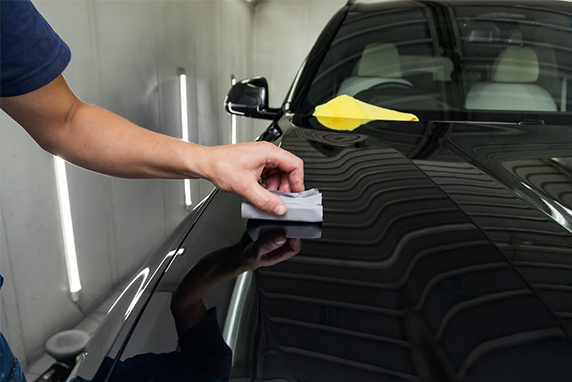
Ceramic coating is renowned for its durability and the exceptional protection it offers against environmental elements, but like all good things, it doesn’t last forever.
Whether you’re a new car owner or a seasoned enthusiast looking to maintain your vehicle’s pristine condition, understanding the lifespan of ceramic coating is essential for maximising its benefits.
Ceramic coating is a liquid polymer that chemically bonds with a vehicle’s factory paint, creating a layer of protection. Unlike traditional waxes and sealants that provide a temporary barrier, ceramic coating significantly enhances the surface’s durability and resistance to environmental hazards. Once applied, it forms a semi-permanent bond with the paint, meaning it does not wash away or break down easily and requires no repeated application every few months.
The primary benefits of ceramic coating include:
The application of ceramic coatings is meticulous and requires a clean, controlled environment. The process generally involves:
The durability of ceramic coatings can generally be expected to last between two and five years, depending on various factors. However, with exceptional care and ideal conditions, some high-quality coatings can protect for up to ten years.
The lifespan of a ceramic coating can vary significantly based on:
Ceramic coatings are designed to be durable, but extreme weather conditions can accelerate their degradation. Intense UV radiation can cause the coating to lose its gloss and effectiveness over time. Similarly, excessive cold can make the coating brittle, increasing the risk of cracking. Frequent exposure to heavy rain and humidity can also erode the coating more quickly by promoting the accumulation of contaminants which may bond to the surface.
Using aggressive cleaning agents on ceramic-coated surfaces can significantly reduce their lifespan. Strong detergents and acidic or alkaline cleaners can strip away the coating’s hydrophobic properties and dull its shine. These substances can weaken the chemical bond between the coating and the paint, leading to faster deterioration and the need for more frequent reapplication.
Using the wrong washing techniques can introduce scratches and swirls to the surface of the coating. Scrubbing the car with abrasive tools or dry wiping can drag dirt and grit across the coating, physically wearing it down.
Polishing a ceramic-coated car is a common mistake that can impair its integrity. While polishing can temporarily enhance the vehicle’s shine, it can also thin the coating layer, reducing its effectiveness at protecting the paint and maintaining its hydrophobic properties.
Two-Bucket Method: Employing the two-bucket method is crucial for minimising the risk of scratching the coating. This technique involves using one bucket for a clean, soap-filled solution and another bucket for rinsing the wash mitt. This method helps keep the wash mitt free of dirt and grit with each pass over the car’s surface.
Avoid Direct Sunlight: Washing a ceramic-coated car in direct sunlight can cause premature drying, which leads to water spots that can etch into the coating. Always wash the vehicle in the shade or during cooler parts of the day to prevent these issues.
Gentle Cleaning Agents: Select pH-neutral shampoos that are specifically formulated for use on ceramic-coated vehicles. These shampoos clean effectively without damaging the hydrophobic properties of the coating. Avoid products that contain harsh solvents or abrasives.
Over time, even the most durable ceramic coatings will begin to show signs of wear and tear. Here are some key indicators that suggest it may be time to consider replacing your ceramic coating:
If you’re looking to get the most out of your ceramic coating, consider the professional services of Col’s Body Shop. Our expert team is dedicated to providing top-tier ceramic coating applications that ensure maximum durability and protection for your car.
Visit our website or contact us today to schedule your appointment and ensure your car gets the best possible protection with our top-quality ceramic coating services.